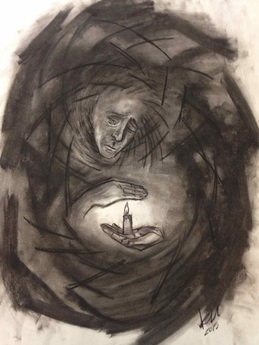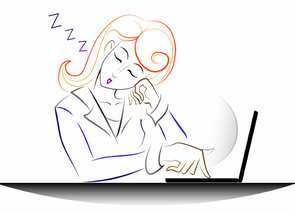The biggest change that I experienced in the Master’s of Educational Technology program was coming to the realization that I didn’t have to continue in my current profession of teaching English as a Second Language. I originally went into the program because I enjoyed the content and thought it would be ideal for implementing into my teaching. What I ultimately learned was that I love the combination of technology and education, and I’m not attached to English as a Second Language as a subject. I like working with the international students, but I need content that is more challenging and inspiring. I also truly enjoy working with teachers. This realization about myself will allow me to move from an ESL position to something more directly related to Educational Technology. I have officially quit my job and am now changing professions.
This epiphany didn’t come all at once, but it slowly came to me after I resigned my previous position. I began to wonder why I was still looking for ESL jobs. The subject that I loved was Educational Technology not low-level grammar instruction. It’s a good thing I sort of fell into this transition because I’m not sure I could have consciously make such a dramatic change.
It’s often difficult to describe why you feel passionately about something and that is the case for me in this situation as well. I began this program because I found the technology I randomly started playing with quite fun. At that point I was in my first post-M.A. degree position, and I thought the certificate program would be good to have on my resume, and it would flesh out what I had already been working with technology-wise. At that point in my job I was using the many different tools that the Learning Management System, Moodle, had available. My colleagues also introduced me to TEDTalks, and I was using This American Life for authentic listening experiences with my ESL students. I considered myself pretty tech savvy, but until I took the certificate courses, I had no idea there were so many tools out there that were so much fun.
The first three classes introduced me to tools I likely would have found on my own at some point, but I discovered them sooner because of the program. I think probably Teaching Understanding with Technology and Adapting Innovative Technology to Education were the reasons I became so interested in the discipline. Not only did we explore technology but we also looked at effective use of the tools in our teaching. We didn’t haphazardly apply technology to our classes, but designed lessons specifically for our class while using technology to support our teaching. As a result of these initial positive experiences, I decided to pursue the full degree.
This epiphany didn’t come all at once, but it slowly came to me after I resigned my previous position. I began to wonder why I was still looking for ESL jobs. The subject that I loved was Educational Technology not low-level grammar instruction. It’s a good thing I sort of fell into this transition because I’m not sure I could have consciously make such a dramatic change.
It’s often difficult to describe why you feel passionately about something and that is the case for me in this situation as well. I began this program because I found the technology I randomly started playing with quite fun. At that point I was in my first post-M.A. degree position, and I thought the certificate program would be good to have on my resume, and it would flesh out what I had already been working with technology-wise. At that point in my job I was using the many different tools that the Learning Management System, Moodle, had available. My colleagues also introduced me to TEDTalks, and I was using This American Life for authentic listening experiences with my ESL students. I considered myself pretty tech savvy, but until I took the certificate courses, I had no idea there were so many tools out there that were so much fun.
The first three classes introduced me to tools I likely would have found on my own at some point, but I discovered them sooner because of the program. I think probably Teaching Understanding with Technology and Adapting Innovative Technology to Education were the reasons I became so interested in the discipline. Not only did we explore technology but we also looked at effective use of the tools in our teaching. We didn’t haphazardly apply technology to our classes, but designed lessons specifically for our class while using technology to support our teaching. As a result of these initial positive experiences, I decided to pursue the full degree.
Even though I was already teaching college, I had very little background in education. It’s acceptable in higher education to simply have a degree in your field and that is the only requirement needed to teach that subject. While in graduate school, I had one class in teaching ESL and a practicum in which I got hardly any feedback from my instructor. So one of the most valuable things I got out of this program was a better understanding of how people learn and how to structure my teaching to better facilitate that process.
Although I have some serious reservations about the structure of the Online Assessments class I am currently taking, it does tend to have some of the more helpful material that gives me more of a foundational understanding of learning. Because I was lacking in pedagogical understanding, this was probably the class that helped me the most. In this instance, we got more information about what students are supposed to be learning (understanding) and how to focus teaching on practical skills. This is especially important for college students who are that much closer to real world uses of their knowledge. One of the big take-aways for me was to be really conscious of what I’m assessing.
A lot of this class involved thinking more deeply about our teaching in general. What are we assessing? Why are we assessing that? Does it serve the students? I already knew that multiple choice question tests were not very effective as an assessment, but because it’s so accepted and so easy, learning about the ineffectiveness of this type of testing helps to reinforce it for me. The other side of this is giving specific and individualized feedback. I also strongly connected to the personalization and connection that happens when assessments are given to individual students. The other area that we focused on was the essential skill of teaching to the students. I already try to do this, but I came to understand other approaches for uncovering the needs of my students.
In this class there was some brief mention of grit and how it applies to student learning. This was not a specific topic within this course, but it was mentioned once or twice, and it’s something that greatly interests me. The idea of grit, perseverance and how it relates to academic and personal success isn’t addressed enough, in my opinion. The idea that learning from mistakes is where real learning happens makes sense to me. It was valuable to have some exposure to this topic within the Electronic Assessments class though.
The other class that had the most impact on me was Learning Tech through Design. My previous work environment was highly dysfunctional – so much so that there were serious questions about whether we would get accreditation when the Higher Learning Commission came around in the spring. I luckily got out of there, but the problem persists. Without going into too much detail, a few examples of the toxicity are random firings, reprimands if faculty spoke out against administration and bullying of the faculty who did speak out – especially if they were women
The design class allowed me to build a really creative project that was to be used to help support the faculty while they tried to do the best for their students. I knew that nothing I did would change the administration, but I wanted to help the faculty. The design process showed me how to empathize with my co-workers. What I chose to do was to ask them, from the perspective of their disciplines, what working there was like for them. The result was that I recieved was artwork, descriptions of pieces of music, opinions expressed through technology and thoughtful essays as well. It was inspiring. Every single full-time faculty responded to me with their honest take – all negative – on what it was like to work under the current administration.
The empathy stage was the best part of the design process for me. Because there was such a high risk of retribution from administration, there wasn’t a lot I could do with the information that I had gathered. But to complete the project, I created a mockup of a forum we could use to share our stories and help each other. Afterward I wrote a personal letter to my co-workers explaining my project and thanking them for contributing. I integrated several of the pieces I received into the letter and ended the project there.
I’m not sure in which of the two certificate classes I was introduced to educational technology tools for the first time, but I now use them so regularly that they are an integrated part of my teaching and personal life. I am now currently obsessed with podcasts, use my RSS readers almost daily and regularly create videos for my students when I integrate new tools into our class. I currently use my RSS reader to monitor new research that comes out, follow the education sections of major newspapers online, as well respected bloggers in the field. I also am using Twitter to help build a community around a blog that I’m developing.
In a perfect world, the project I’m currently working on would develop into something that I could maybe support myself with. I’m realistic, but since I’m presently unemployed I have no reason not to put my full effort into it. While I was looking for a blog that focused on research in education and educational technology, I couldn’t find any. I’m sure they’re out there, but they are hard to find, and I specifically didn’t find any that concentrated on current research. Since I was already looking for an additional piece for my portfolio in my capstone class, I thought this was an excellent opportunity.
However, there is already a lot of information on the Interest about research in the field of Education. I didn’t want to add to the academically focused material. I wanted something more engaging and different. So I chose to create a blog about educational technology from a creative perspective. I’ll use creative media – writing, videos, etc. – to explore new research in the field. I wanted it to be fun, entertaining and not dull in the least. I have called it Ed Tech for the Funky Ones. I’m pretty excited about it. I also want it to create a community around itself, so I plan on creating questions and involving the audience. I understand that this is an ambitious project, but it’s exciting and truly unique in my opinion.
The classes that I’ve taken in the MAET program have brought me to where I am currently. I have a better understanding of how people learn, which allows me to create lessons that are supported by this knowledge. I now know more about how to structure my lessons so they’re focused on what I actually want the students to learn. I have changed my profession because as I refine my skills, I’m refining how I want to live my life and which profession I want to pursue. I know more about the technology that is available out there as well as how to design classes for the needs of my students. I have also found an ongoing professional development project that will ideally create a community and present research in a creative way. These are the things that I would like think I learned in this program. My goal is to take all these lessons and integrate them into who I am as an educator, which is yet another lesson that I learned: the practical application of the knowledge I’ve gathered from the MAET program.
However, there is already a lot of information on the Interest about research in the field of Education. I didn’t want to add to the academically focused material. I wanted something more engaging and different. So I chose to create a blog about educational technology from a creative perspective. I’ll use creative media – writing, videos, etc. – to explore new research in the field. I wanted it to be fun, entertaining and not dull in the least. I have called it Ed Tech for the Funky Ones. I’m pretty excited about it. I also want it to create a community around itself, so I plan on creating questions and involving the audience. I understand that this is an ambitious project, but it’s exciting and truly unique in my opinion.
The classes that I’ve taken in the MAET program have brought me to where I am currently. I have a better understanding of how people learn, which allows me to create lessons that are supported by this knowledge. I now know more about how to structure my lessons so they’re focused on what I actually want the students to learn. I have changed my profession because as I refine my skills, I’m refining how I want to live my life and which profession I want to pursue. I know more about the technology that is available out there as well as how to design classes for the needs of my students. I have also found an ongoing professional development project that will ideally create a community and present research in a creative way. These are the things that I would like think I learned in this program. My goal is to take all these lessons and integrate them into who I am as an educator, which is yet another lesson that I learned: the practical application of the knowledge I’ve gathered from the MAET program.



